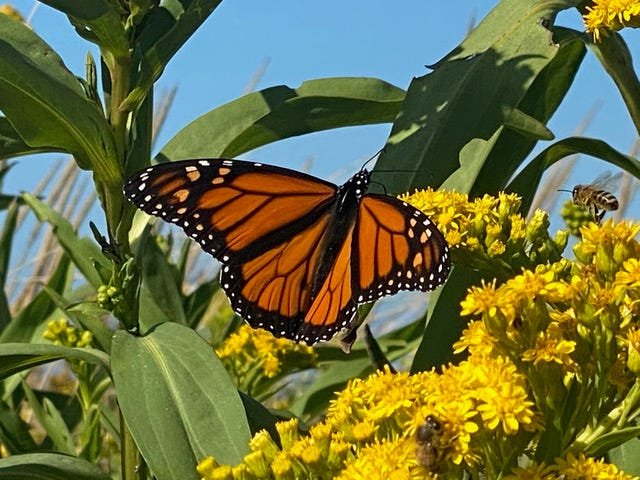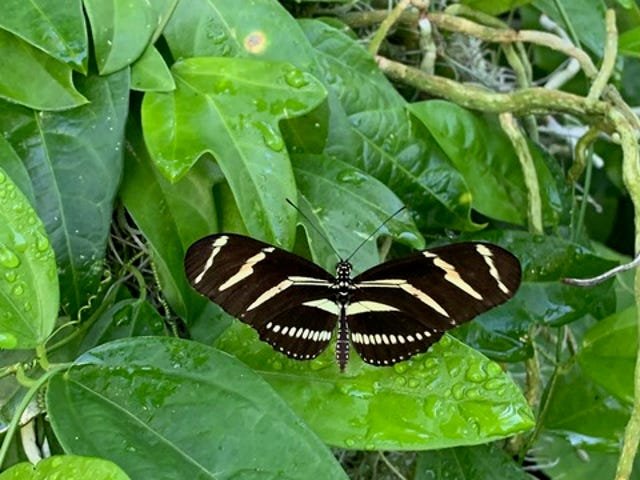Preservation Foundation botanical art exhibit a reminder of Florida's native beauty
Plant native flora and you will have butterflies and bees, helping preserve Palm Beach’s natural ecosystems.
January 30, 2021
Botanical subjects have long inspired artists, with illustrations of plants dating back to 1465 BC in ancient Egypt.
Specific plants used for medicinal purposes were compiled into "herbals" as early as 512 AD. John Gerard’s 1,484-page illustrated Herbal, or Generall Historie of Plantes, was first published in 1597 and was standard medicinal plant reference for more than a century.
In 1613, Basilius Besler, a noted apothecary and botanist in Nuremburg, Germany, published the incomparable Florilegium: Hortus Eystettensis, compiling 373 full-color plates of more than 1,000 accurate illustrations of flowers into possibly the best record of plants grown in European gardens in the 16th century. Still regarded as one of the most important botanical books ever written, this was the first time flowering plants were portrayed as objects of beauty, changing the emphasis from medicinal herbs toward more aesthetic artistry.
The monarch butterfly emerges from a chrysalis on a spider lily leaf
These early botanists paved the way for Maria Sybilla Merian, Carl Linnaeus, Mark Catesby, George Ehret and John Bartram, all of whom carefully studied and recorded the intricacies of the relationships of plants with their environments. Linnaeus, of course, devised the system of plant classification and botanical nomenclature we still use today, using genus and species to correctly identify plants.
Possibly the most famous plant illustrator of all was France's Pierre-Joseph Redouté, who was artist to Queen Marie Antoinette and later to the Empress Josephine, creating 2,100 paintings of more than 1,800 different species of flowers, most importantly roses, over an 80-year career.
Botanical illustrators are still highly regarded for the aesthetic beauty of their works, which often include the medicinal values of the plants they depict. When Bartram and Catesby came to Florida, they marveled at the beautiful ancient forests, grasslands, rivers and estuaries teeming with birds and wildlife, which they later committed to illustration. John James Audubon’s extensive and still current Birds of America almost always showed his individual avian specimens on native host plants.
Sadly, the Florida these explorers discovered and chronicled has largely disappeared, and with it, the natural ecosystems that supported the vast numbers of birds, insects and wildlife that made this landscape so unique. In collaboration with the American Society of Botanical Artists, the Preservation Foundation has compiled an extraordinary collection of botanical art specifically dedicated to Florida’s native plants.
These paintings and drawings depict the exquisite beauty as well as the essential role natives play in establishing, supporting and maintaining healthy ecosystems. Without them, we cannot sustain the paradise we know and love as Palm Beach.
I want to elaborate on a few of the plants included in the Preservation Foundation’s exhibit, appropriately named Wildly Exquisite: Florida’s Native Plants, and would encourage all of you to visit the exhibition (which runs through April 2) and then wander through the lovely Pan’s Garden and see some of the specimens in person.
A zebra longwing butterfly rests on a maypop leaf
Maypop (Passiflora incarnata) is shown as a lovely watercolor on vellum highlighting the extravagant lavender blue flowers, seedpods and delicate, but terrifically sturdy tendrils of this beautiful native vine. This is one of the larval hosts for the zebra longwing, Julia, Gulf and variegated fritillary butterflies; the blossoms also provide nectar for numerous adult butterflies and pollinators.
The Cherokee called this vine "ocoee" and used it for a variety of medicinal treatments; it contains alkaloids and flavonoids effective as non-addictive sedatives, reducing blood pressure and increasing respiratory function. This exquisitely ornamental and important native plant deserves a place in any Florida garden..
The fronds of a sabal palm
The “boots” of a sabal palm
Cabbage or sabal palm (Sabal palmetto) drawn with colored pencil on paper, shows the delicate, ornamental frond of Florida’s state tree. The flowers of this palm are a nectar source for numerous pollinators and the berries provide food for native wildlife. Native Seminoles used the berries and seeds to treat headaches and fevers, and they made a bread from the sweet, prune-flavored fruit.
Leaves from the palmettos were used as roofing thatch and made into baskets and lashing strips. The rot-resistant trunks used in home construction also furnished wharf pilings. This versatile tree is a stunning ornamental with long clusters of fragrant white flowers in early summer. Tolerant of a wide range of environmental conditions, sabal palm is extremely valuable in any home landscape.
Coral Honeysuckle
Coral honeysuckle (Lonicera sempervirens) is exhibited with colored pencil on film, showing a hummingbird approaching the elongated orange red tubular flowers. This delightful native vine is a perennial favorite of hummingbirds and will bring orioles, mockingbirds, catbirds, thrushes and other birds to your gardens. Larger butterflies such as swallowtails also visit the blossoms. Small red berries attractive to birds and wildlife appear in autumn.
Medicinally, the fruit is emetic and cathartic; juice from the plant is beneficial in treating bee stings, and dried, smoked leaves serve as a treatment for asthma. This will provide a delightful burst of color to your garden year- round, with the most prolific blooming in spring. Not particular as to soil, Lonicera does well in full sun or part shade, and requires little attention once established.
The graceful spider lily (Hymenocallis latifolia) is presented as a watercolor with colored pencil and graphite on paper. This truly stunning native will add a glorious sparkle of brilliant white to your garden, tolerating most soils and even beach conditions. Long strap-like leaves rise from a central bulb base forming attractive dense clumps, making this a perfect ground cover, accent plant, or border planting.
The flowers have crown-like centers above six long, slender upward-curving petals, creating a star-like appearance. Six upright stamens add to the elegant effect. Also known as perfumed spider lily, the flowers have a lovely soft scent and are pollinated by the sphinx moth. Considering its delicate beauty, this is a surprisingly adaptable plant; try it in your garden.
And the oft-overlooked elderberry (Sambucus canadensis) is depicted with watercolor and colored pencil on paper, and provides a wonderful rendering of the many stages in the life cycle of this important, decorative native. This multi-stemmed shrub provides cover and food for songbirds, butterflies and other pollinators, with showy clusters of creamy white flowers followed by numerous purplish black berries. These berries (which are irresistible to birds) are wonderful in syrups, teas, and pie, and are even made into wine.
Elderberry cordial — cooked elderberries served with ice, tonic and a squeeze of lime — makes a refreshing summer drink. The berries are loaded with vitamin C and antioxidants and have long been used for medicinal purposes. This is another wonderful native you’ll love adding to your landscape.
Many thanks to the Preservation Foundation and the American Society of Botanical Artists for providing this wonderful exhibition highlighting the aesthetic beauty of Florida’s native species as well as their intrinsic importance to the landscapes we inhabit. Native plants support and nourish the insects and pollinators vital to our subsistence: “the little creatures that run the world." We all need to appreciate our obligations as stewards of our land: what we plant truly matters to the future of our island paradise.
Special thanks to Susan Lerner, director of horticulture at the Preservation Foundation, for her tireless efforts in promoting the importance of native plants through varied educational platforms including exhibits such as this.
-Kim Frisbie
Original article on the Palm Beach Daily News is HERE.






